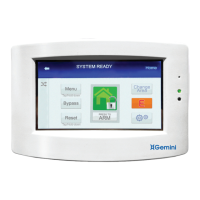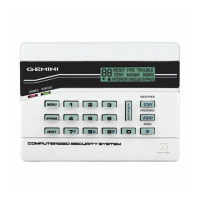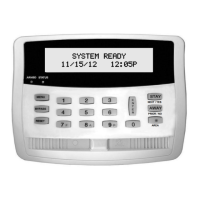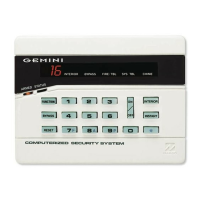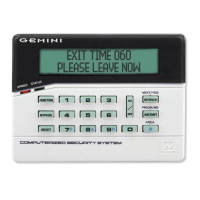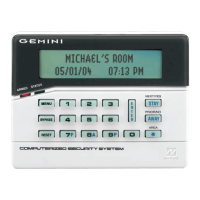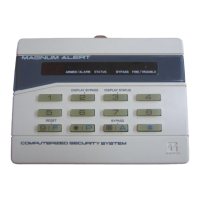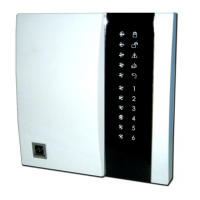Do you have a question about the NAPCO Gemini GEM-K1CA and is the answer not in the manual?
Instructions for testing the sounding device and backup battery performance.
Instructions for testing the central station communicator's functionality.
Explains the window display and STATUS/ARMED indicator lights for system status.
Details the functions of MENU, BYPASS, RESET, ENTER, STAY, and AWAY buttons.
Covers numerical keys and dedicated emergency buttons for system interaction.
Steps for arming the system, priority arming, and zone bypassing when leaving premises.
Handling system troubles, area arming, manager's mode, and global arming options.
How to arm the system for home protection, allowing interior movement.
How to arm with immediate alarm upon entry door opening.
Using Easy Exit option and dedicated emergency buttons for safety.
Steps to disarm the system when returning to the premises.
How to handle and silence an alarm condition.
How to use the Ambush Code for a silent alarm.
Procedures for responding to fire alarms and trouble conditions.
Guidance on creating and rehearsing fire escape plans for occupants.
Space provided to draw a plan of the premises for escape routes.
Reasons why fire alarm systems may fail to provide adequate warning.
Steps to enter the function menu for system utilities.
Displaying zone faults, bypassed zones, and zone directory information.
Functions for bell test, displaying system and fire troubles/alarms.
Functions to activate Chime and Watch modes for system monitoring.
Procedures to reset system troubles and sensor watch failures.
Manually starting exit delay, useful for commercial systems.
Sends a communicator test signal to the central station.
Sets the system to arm automatically after a specified delay.
Activates program mode and download features for system configuration.
Turns programmed Relay Groups ON or OFF.
Details about the digital communicator's reporting capabilities.
Explanation of abort delay and opening/closing reporting to central station.
How to bypass or unbypass zones in high-security applications.
Features like starting exit time after ringback and exit-delay restart.
Steps required to enter the User Program Mode.
How to program, reprogram, or erase user access codes.
How to review codes and exit the user programming mode.
Steps to enter the User Program Mode for zone description entry.
How to enter zone descriptions using cell phone-style entry.
Steps to enter the User Program Mode for setting date and time.
How to set the system date using the keypad.
How to set the system time using the keypad.
Displays for system ready, arming, exit/entry delays, and zone faults.
Displays for general alarms, fire alarms, and trouble conditions.
Codes for AC power, low battery, communication failures, and cancellations.
Definitions for Arming/Disarming, BYPASS Button, Central Station, Communicator.
Definitions for Ambush Code, Area, Easy Arming, Closing Window, Manager's Mode.
Definitions for Panic Buttons, Ringback, Sounder, System Trouble, and various Zone types.
Error codes for AC Power Failure, Low Battery, and Communication Failure.
Codes for wireless transmitter failures, receiver response, and line cuts.
Codes for keypad issues, module errors, transmitter tamper, and detector faults.
Codes for program memory errors, sensor watch failures, and maintenance needs.
Codes for RF self-test, fire trouble, bell/siren issues, and dirty smoke detectors.
What to do when the system displays 'ZONES NOT NORMAL'.
What to do when the system displays 'SYSTEM TROUBLE' with error codes.
How to silence and address a sounding fire alarm.
Instructions for testing the sounding device and backup battery performance.
Instructions for testing the central station communicator's functionality.
Explains the window display and STATUS/ARMED indicator lights for system status.
Details the functions of MENU, BYPASS, RESET, ENTER, STAY, and AWAY buttons.
Covers numerical keys and dedicated emergency buttons for system interaction.
Steps for arming the system, priority arming, and zone bypassing when leaving premises.
Handling system troubles, area arming, manager's mode, and global arming options.
How to arm the system for home protection, allowing interior movement.
How to arm with immediate alarm upon entry door opening.
Using Easy Exit option and dedicated emergency buttons for safety.
Steps to disarm the system when returning to the premises.
How to handle and silence an alarm condition.
How to use the Ambush Code for a silent alarm.
Procedures for responding to fire alarms and trouble conditions.
Guidance on creating and rehearsing fire escape plans for occupants.
Space provided to draw a plan of the premises for escape routes.
Reasons why fire alarm systems may fail to provide adequate warning.
Steps to enter the function menu for system utilities.
Displaying zone faults, bypassed zones, and zone directory information.
Functions for bell test, displaying system and fire troubles/alarms.
Functions to activate Chime and Watch modes for system monitoring.
Procedures to reset system troubles and sensor watch failures.
Manually starting exit delay, useful for commercial systems.
Sends a communicator test signal to the central station.
Sets the system to arm automatically after a specified delay.
Activates program mode and download features for system configuration.
Turns programmed Relay Groups ON or OFF.
Details about the digital communicator's reporting capabilities.
Explanation of abort delay and opening/closing reporting to central station.
How to bypass or unbypass zones in high-security applications.
Features like starting exit time after ringback and exit-delay restart.
Steps required to enter the User Program Mode.
How to program, reprogram, or erase user access codes.
How to review codes and exit the user programming mode.
Steps to enter the User Program Mode for zone description entry.
How to enter zone descriptions using cell phone-style entry.
Steps to enter the User Program Mode for setting date and time.
How to set the system date using the keypad.
How to set the system time using the keypad.
Displays for system ready, arming, exit/entry delays, and zone faults.
Displays for general alarms, fire alarms, and trouble conditions.
Codes for AC power, low battery, communication failures, and cancellations.
Definitions for Arming/Disarming, BYPASS Button, Central Station, Communicator.
Definitions for Ambush Code, Area, Easy Arming, Closing Window, Manager's Mode.
Definitions for Panic Buttons, Ringback, Sounder, System Trouble, and various Zone types.
Error codes for AC Power Failure, Low Battery, and Communication Failure.
Codes for wireless transmitter failures, receiver response, and line cuts.
Codes for keypad issues, module errors, transmitter tamper, and detector faults.
Codes for program memory errors, sensor watch failures, and maintenance needs.
Codes for RF self-test, fire trouble, bell/siren issues, and dirty smoke detectors.
What to do when the system displays 'ZONES NOT NORMAL'.
What to do when the system displays 'SYSTEM TROUBLE' with error codes.
How to silence and address a sounding fire alarm.
